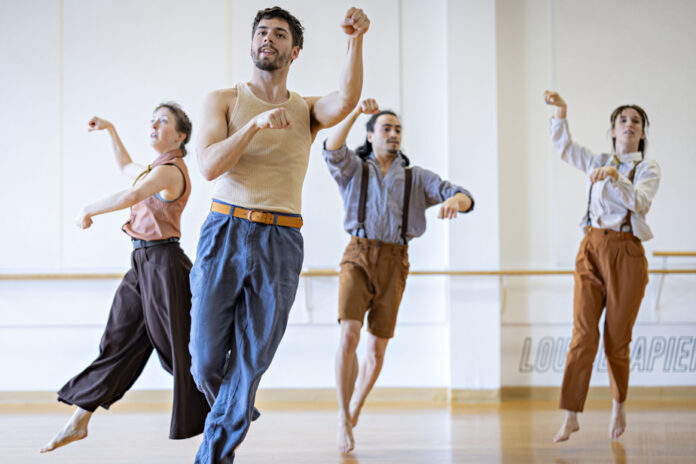Mythical character of Quebec folklore, Alexis le Trotteur, the man who ran faster than horses, continues to inspire. As next year marks the 100th anniversary of his death, Ample Man Danse brings his legend to life on stage in Alexis, a contemporary dance performance created for teenagers… and thanks to them.
Four horse-dancers gallop through the rehearsal studio. If they obviously do not have the same physique as the animal, they borrow from it its gait, its strength, its presence, even its hoof kick and its whinnying. In the center of the room, dressed in the style of early 20th-century peasants, choreographer Simon Ampleman proclaims the exploits of Alexis Lapointe, known as Le Trotteur, before his comrades launch into a series of movements sometimes reminiscent of the superhuman energy, sometimes the beauty of the athlete who exceeded even the trains.
To build this show, which will premiere at the Maison des arts de Laval next Monday as part of the Rencontre Théâtre Ados festival, the troupe was able to rely on the impressive research work carried out by playwright Mélanie Viau. “We relied on hundreds of testimonials from people who saw it,” says Simon Ampleman.
But beyond the historical material, it is mainly from exchanges with groups of teenagers that this “multidisciplinary choreographic creation” was built, intended for an audience of 12 years and over.
At the start of the 20-month project, the artistic director of Ample Man Danse traveled to high schools to meet with students. “I told them the story of Alexis and asked them, ‘What do you remember? What’s bothering you? What’s coming for you?” And there the themes emerged from them. »
Clothing is an example. “Alexis was very proud because he thought he would develop social bonds by being well dressed. […] He was like, ‘Because of my clothes, people are going to like me,'” says Simon Ampleman.
The choreographer recalls that Alexis Lapointe was a curious character who had difficulty being accepted by society and, above all, by his family, one of the other themes explored.
Gestures, taken up in the show, were also born of these two weeks spent with young people from various backgrounds.
And even when Alexis comes to life on stage, the teenagers who will attend, with their family or their school, the performances will continue to influence the work. How ? By deciding, for example, on the superpowers to be granted to the horse-dancers or by choosing the soundtrack for one of the paintings.
This interactive aspect helps create a connection between the public and the artists, believes Simon Ampleman.
For young people who will see the show as part of a school outing, this relationship has already begun to be established: as part of the Rencontre Théâtre adolescent festival, schools are not only invited to the theater, they also have the chance to welcome artist-mediators some time before the performance.
“It’s important that young people have the keys to understanding the play, because it’s not easy, going to the theater. It’s not like going to the cinema. There is a decorum at the level of the theater that I find very important to bring when we do mediation projects,” explains Sylvie Lessard, general and artistic director of the Teen Theater Meeting, whose festival, which runs until April 29, is in its 27th edition.
And what does a cultural mediation workshop look like? “In class, we chat, we meet, we discover each other,” says Simon Ampleman, whose troupe regularly hosts such sessions for a variety of audiences, from toddlers to seniors. “Mediation is there to create a connection with the artist. Seeing him on stage puts him on a pedestal. To meet him as a human, it develops a closeness, a confidence. When trust is established, this is where openness occurs and sincere sharing exists. »















